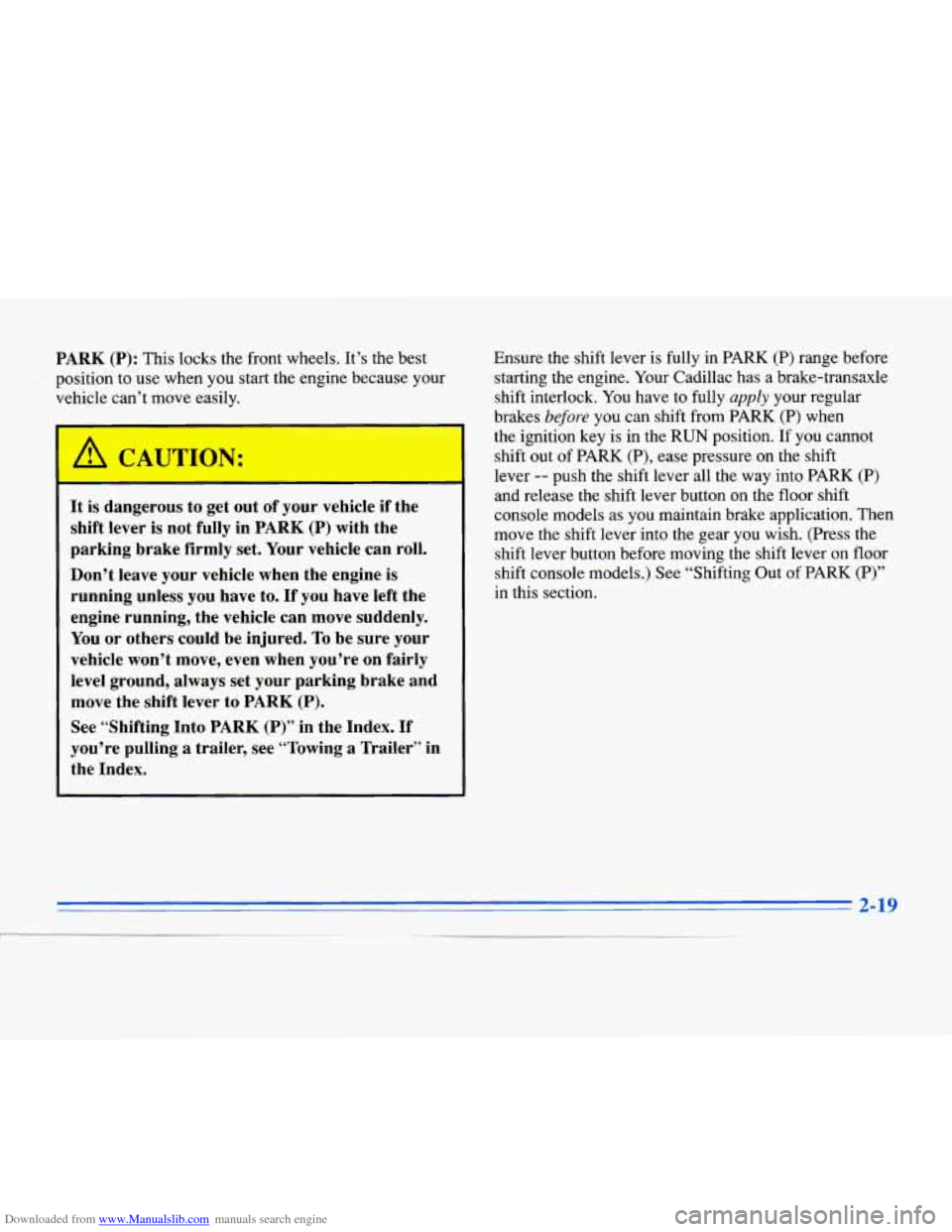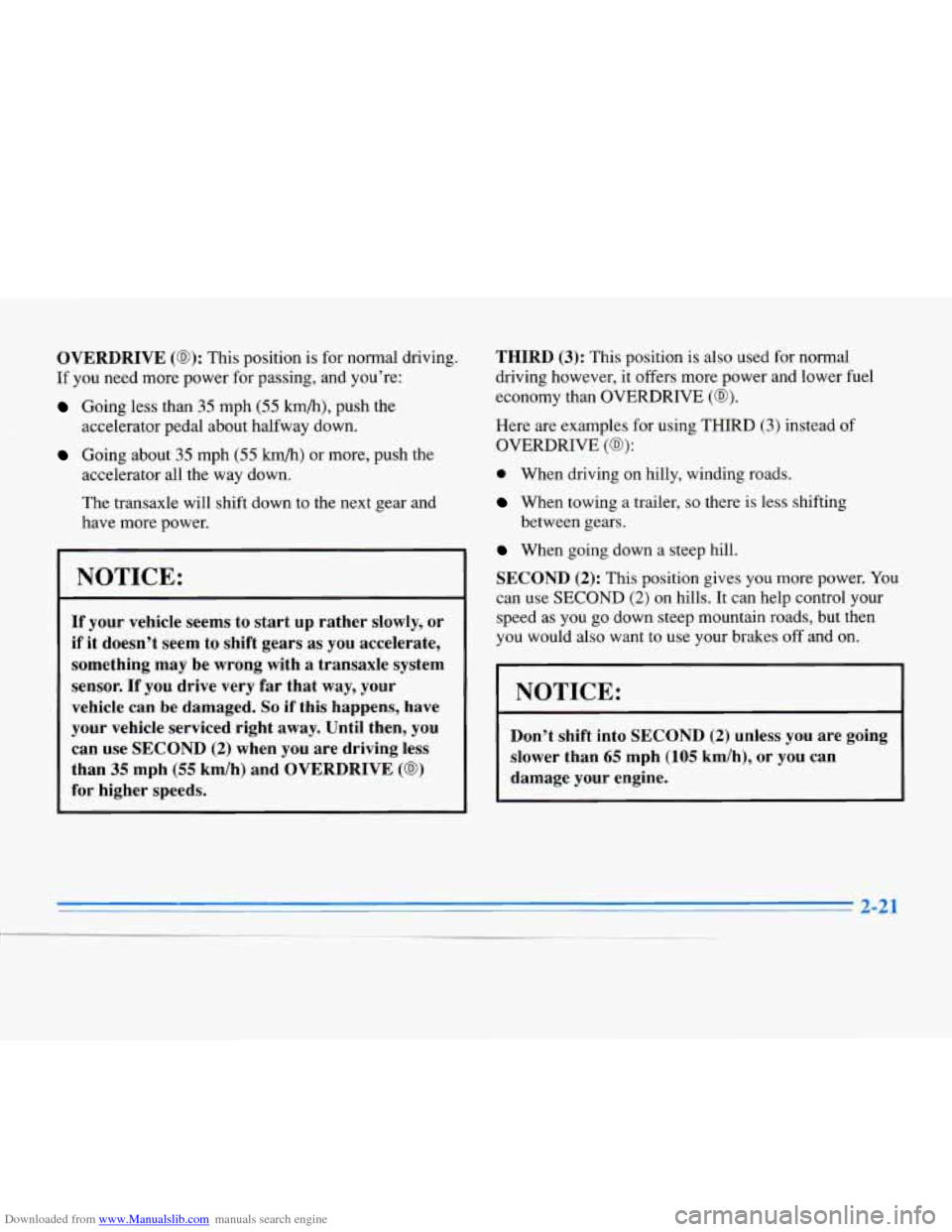Page 11 of 354
Downloaded from www.Manualslib.com manuals search engine The electronics and computerization which were
pioneered by Cadillac
in the ’70s came of age in the
’80s with Digital Fuel Injection and On-Board
Diagnostics in
1980, four wheel Anti-lock Brakes on
1986 models and Traction Control in the fall of 1989.
The 1992 Seville STS was the first car ever to win all
three major automotive awards: Car
of the Year, Motor
Trend; Ten Best List, Car
& Driver; Car of the Year,
Automobile Magazine.
The year
1993 saw the introduction of the Northstar
system. The state of
the art system includes the 32 valve,
dual overhead camshaft, Northstar
4.6 liter V8 engine,
4T80-E electronically controlled automatic transaxle,
road sensing suspension, speed sensitive steering,
anti-lock brakes and traction control.
For more than nine decades Cadillac has been a leader in
quality and technical innovation.
Now more than ever,
Cadillac is “Creating
a Higher Standard.”
X
Page 14 of 354
Downloaded from www.Manualslib.com manuals search engine Vehicle Symbols
These are some of the symbols you will find on your vehicle.
For example,
these symbols
are used on an
original battery:
POSSIBLE A
CAUTION
INJURY
PROTECT EYES BY
SHIELDING
CAUSTIC
BURNS AVOID
SPARKS
OR
FLAMES
SPARK
OR ,\I/,
COULD FLAME
EXPLODE BAITERY
These symbols
are important
for you and
your passengers
whenever your
vehicle is
driven:
DOOR LOCK
UNLOCK
FASTEN SEAT
BELTS
n
These symbols
have
to do with
your lights:
SIGNALS e e3
TURN
FOG LAMPS
& 0
These symbols are on some
of
your controls:
WINDSHIELD
WIPER
WINDSHIELD DEFROSTER
VENTILATING FAN
These symbols
are used on
warning and
indicator lights:
COOLANT -
TEMP -
CHARGING F’J
BATTERY
SYSTEM
BRAKE
(0)
COOLANT a
ENGINE OIL e,
PRESSURE
ANTI-LOCK
(@)
BRAKES
Here are some
other symbols
you may see:
FUSE
LIGHTER HORN
)tr
SPEAKER
cr
FUEL p3
xiii
,
Page 80 of 354

Downloaded from www.Manualslib.com manuals search engine PARK (P): This locks the front wheels. It’s the best
position to use when you start the engine because your
vehicle can’t move easily.
It is dangerous to get out of your vehicle if the
shift lever is not fully in
PARK (P) with the
parking brake firmly set. Your vehicle can roll.
Don’t leave your vehicle when the engine is
running unless you have to. If you have left the
engine running, the vehicle can move suddenly.
You or others could be injured.
To be sure your
vehicle won’t move, even when you’re on fairly
level ground, always set your parking brake and
move the shift lever to
PARK (P).
See “Shifting Into PARK (P)” in the Index. If
you’re pulling
a trailer, see “Towing a Trailer” in
the Index. Ensure
the shift lever is fully in PARK
(P) range before
starting the engine. Your Cadillac has a brake-transaxle
shift interlock. You have to fully
apply your regular
brakes
before you can shift from PARK (P) when
the ignition key is in the
RUN position. If you cannot
shift out of PARK
(P), ease pressure on the shift
lever
-- push the shift lever all the way into PARK (P)
and release the shift lever button on the floor shift
console models
as you maintain brake application. Then
move the shift lever into the gear you wish. (Press the
shift lever button before moving the shift lever on
floor
shift console models.) See “Shifting Out of PARK (P)”
in this section.
2-19
Page 82 of 354

Downloaded from www.Manualslib.com manuals search engine OVERDRIVE (0): This position is for normal driving.
If you need more power for passing, and you’re:
Going less than 35 mph (55 km/h), push the
accelerator pedal about halfway down.
Going about 35 mph (55 km/h) or more, push the
accelerator all the way down.
The transaxle will shift down to the next gear and
have more power.
NOTICE:
If your vehicle seems to start up rather slowly, or
if it doesn’t seem to shift gears
as you accelerate,
something may be wrong with
a transaxle system
sensor. If
you drive very far that way, your
vehicle can be damaged.
So if this happens, have
your vehicle serviced right away. Until then, you
can use SECOND
(2) when you are driving less
than
35 mph (55 km/h) and OVERDRIVE (a)
for higher speeds. THIRD
(3): This
position is also used for noma
driving however, it offers more power and lower fuel
economy than OVERDRIVE
(03).
Here are examples for using THIRD (3) instead of
OVERDRIVE (03):
0 When driving on hilly, winding roads.
When towing a trailer, so there is less shifting
When going down a steep hill. between gears.
SECOND
(2): This position gives you more power. You
can use SECOND
(2) on hills. It can help control your
speed as you go down steep mountain roads, but then
you would also want
to use your brakes off and on.
I I
I NOTICE:
Don’t shift into SECOND (2) unless you are going
slower than
65 mph (105 km/h), or you can
damage your engine.
1
Page 83 of 354

Downloaded from www.Manualslib.com manuals search engine FIRST (lji This position gives you even more power Parking Brake
than SECOND (2). You can use it on very steep hills,
or
in deep snow or mud. (If the shift lever is put in
FIRST (l), the transaxle won’t shift into gear until the
vehicle is
going slowly enough.)
NOTICE: - --
If your front wheels can’t rotate, don’t try to
dri.ve. This-might happeh if
you were stuck in
very.deep sand or mud
or were up against a solid
object.
You could damage your transaxle.
Also, if you stop when going uphill, don’t hold Hold
the regular brake
pedal down with your right
foot and push, down the
parking brake pedal with
your left foot to set the
parking brake.
If the
ignition is on, the PARK
BRAKE indicator light
will come ,on.
your vehicle there with only the accelerator
If you try to drive off with the parking brake on, the
pedal.
This could cause overheating and damage PARK BRAKE indicator light stays on. See “Parking
the transaxle. Use
your brakes to hold your
Brake Indicator Light” in the Index for more
vehicle in position on
a hill. information.
When you move out
of PARK (P) or NEUTRAL.(N),*if
the engine is running, the p&king brake should release. If
it doesn’t, you can manually release the parking brake.
Page 84 of 354
Downloaded from www.Manualslib.com manuals search engine Reach under the driver’s side of the instrument panel
and pull
on the manual release lever, which is located
above the parking brake pedal. If the parking brake does
not release, you will have to have your vehicle serviced.
A CAUTION:
-
If your hand or arm is in the way of the pedal,
you could be hurt. The pedal springs back quickly. Keep your hand and arm away when
you use the manual release lever.
NOTICE:
Driving with the parking brak6 bn’can cause
your rear brakes to overheat. You may have to
replace them and you could also damage other
parts
of your vehicle.
If you are towing a trailer and are parking on a hill, see
“Towing a Trailer’’ in the Index. This section shows
what to do first to keep the trailer from moving.
2-23
Page 88 of 354

Downloaded from www.Manualslib.com manuals search engine Shifting Out of PARK (P)
Your Cadillac has a brake-transaxle shift interlock. You
have to fully
apply your regular brakes before you can
shift from PARK (P) when the ignition is in the RUN
position. See “Automatic Transaxle” in the Index.
If you cannot shift out of PARK (P), ease pressure
on
the shift lever -- push the shift lever all the way into
PARK
(P) and also release the shift lever button on floor
shift models as
you maintain brake application. Then
move the shift lever into
the gear you want. (Press the
shift lever button before moving the shift lever.) If you
ever hold the brake pedal down but still can’t shift out of
PARK (P), try this:
1. Turn the key to OFF. Open and close the driver’s
door to turn off the Retained Accessory Power
feature.
2. Apply and hold the brake until the end of Step 4.
3. Shift to NEUTRAL (N).
4. Start the vehicle and then shift to the drive gear
you want.
5. Have the vehicle fixed as soon as you can.
Parking Over Things That Burn
Things that can burn could touch hot exhaust
parts under your vehicle and ignite. Don’t park
over papers, leaves, dry grass or other things that
can burn.
2-27
1
Page 96 of 354

Downloaded from www.Manualslib.com manuals search engine Cruise Control
I
With cruise control, you can maintain a speed of about
25 mph (40 kmb) or more without keeping your foot on
the accelerator. This can help on long trips. Cruise
control does not work at speeds below about
25 mph
(40 hb).
Cruise control shuts off when you apply your brakes.
I
Cruise control can be dangerous where you
can’t drive safely at
a steady speed. So,
don’t use your-cruise control on winding
roads or in heavy traffic.
slippery roads. On such roads, fast changes
in tire traction can cause needless wheel
spinning, and you could lose control. Don’t
use cruise control on slippery roads.
Cruise control can be dangerous on
If your vehicle is in cruise control when the traction
control system begins to limit wheel
spin, the cruise
control will automatically disengage. (See “Traction Control System” in the Index.) When road conditions
allow you to safely use
it again, you may turn the cruise
control back on.
2-35